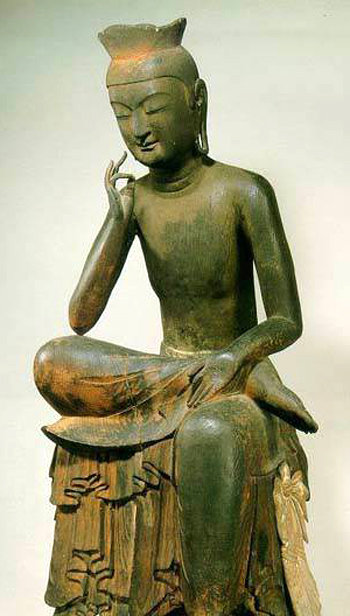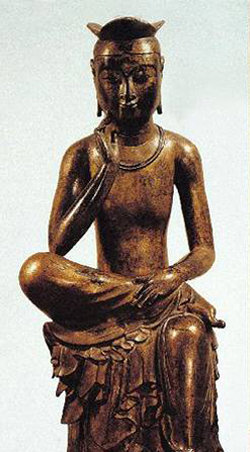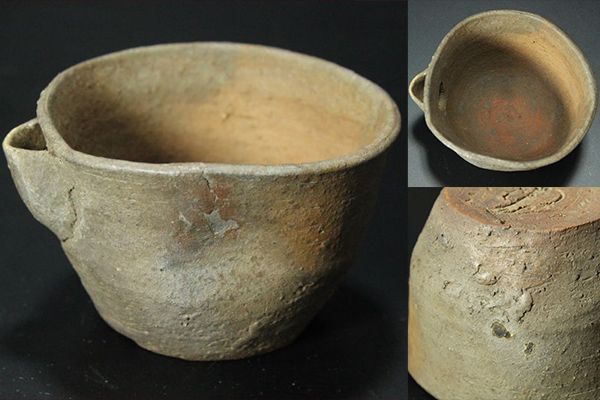Sep 17th, '15, 08:12
Posts: 1885
Joined: Mar 22nd, '08, 22:26
Location: Yixing
by chrl42 » Sep 17th, '15, 08:12
William wrote:Tead Off wrote:Ido chawan were originally soup bowls. The enormous influence they had on Japanese ceramics is evident even today. Some of the greatest Korean chawan are given great places of honor in museums and collections in Japan. Big, oversized, and rustic looking, made by potters who were making practical everyday pottery.
The influence of Korea (on pottery and tea ceremonies) can't be delimited to mere tea bowls ..

Yeah..
like

This is Japan national treature no.1..

This Korea national treasure no.83
Both almost look the same except one made of wood and the other made of metal. Japan, the country was civilized after huge and continuous immigrations of Korea and China...asians, regardless of their similar roots, never stop to fight and quarrel even to this day...guess it's time to sieze

Sep 17th, '15, 08:24
Posts: 130
Joined: Oct 17th, '10, 11:04
by hobin » Sep 17th, '15, 08:24
debunix wrote:hobin wrote:
This part sums up the essence of bizen:
"In contrast, the colors of Bizen ware are anything but vivid.” [...]

Earth tones, sure, but plenty vivid!
contemporary bizen is somewhat different from its momoyama model. this yunomi is beaufiful in any case (is it shunko-enn kiln?)
by contrast this is a yuzamashi by shunko nishimura (the original founder of the first shunko kiln)
-
Attachments
-

- aed4d1ae6fc012e18eefd339e99b975c.jpg (36.67 KiB) Viewed 1437 times
Sep 17th, '15, 10:37
Posts: 5896
Joined: Jan 10th, '10, 16:04
Location: Los Angeles, CA
by debunix » Sep 17th, '15, 10:37
PolyhymnianMuse wrote:debunix wrote:hobin wrote:
This part sums up the essence of bizen:
"In contrast, the colors of Bizen ware are anything but vivid.” [...]

Earth tones, sure, but plenty vivid!
Where did you get such a beautiful cup?
From
Magokorodo eBay shop
hobin wrote:contemporary bizen is somewhat different from its momoyama model. this yunomi is beaufiful in any case (is it shunko-enn kiln?)
by contrast this is a yuzamashi by shunko nishimura (the original founder of the first shunko kiln)
SHUNKO-EN, Firewood calcination KINSAI teacup.
Sep 17th, '15, 13:47
Posts: 4536
Joined: Apr 1st, '09, 00:48
Location: Bangkok
by Tead Off » Sep 17th, '15, 13:47
chrl42 wrote:William wrote:Tead Off wrote:Ido chawan were originally soup bowls. The enormous influence they had on Japanese ceramics is evident even today. Some of the greatest Korean chawan are given great places of honor in museums and collections in Japan. Big, oversized, and rustic looking, made by potters who were making practical everyday pottery.
The influence of Korea (on pottery and tea ceremonies) can't be delimited to mere tea bowls ..

Yeah..
like

This is Japan national treature no.1..

This Korea national treasure no.83
Both almost look the same except one made of wood and the other made of metal. Japan, the country was civilized after huge and continuous immigrations of Korea and China...asians, regardless of their similar roots, never stop to fight and quarrel even to this day...guess it's time to sieze

For years, I always remembered this Korean masterpiece after running across it in many books. When I finally saw it at the National Museum, I realized that no photo could do it justice. The bend in the back of the seated figure is amazing when viewed from its profile.
However, after visiting the sites in Nara and seeing the wooden masterpieces from 7/8th century Japan, it was one of the most overwhelming experiences I've ever had. The Japanese were truly the masters of wood carving. Speechless.

Sep 17th, '15, 20:53
Posts: 1885
Joined: Mar 22nd, '08, 22:26
Location: Yixing
by chrl42 » Sep 17th, '15, 20:53
Tead Off wrote:For years, I always remembered this Korean masterpiece after running across it in many books. When I finally saw it at the National Museum, I realized that no photo could do it justice. The bend in the back of the seated figure is amazing when viewed from its profile.
However, after visiting the sites in Nara and seeing the wooden masterpieces from 7/8th century Japan, it was one of the most overwhelming experiences I've ever had. The Japanese were truly the masters of wood carving. Speechless.

7/8th c. Japan hardly had so much civilization in it..it's been known the wood (redden pinewood) used for the Japan national treasure is only grown in south-east Korea..
Yamato Japan was a regime founded by immigrants from Korea and China..after absorbing both cultures and underwent a feudal period, the unified Edo Japan surpassed Chosun Korea, both economically and culturally. Then they opended a trade with West, started a motto 'anything West is better'..Meiji Japan surpassed China in many aspects.
Last edited by
chrl42 on Sep 17th, '15, 22:47, edited 1 time in total.
Sep 17th, '15, 22:30
Posts: 1657
Joined: Sep 2nd, '13, 03:22
Location: in your tea closet
Been thanked: 1 time
by kyarazen » Sep 17th, '15, 22:30
i think chamaecyparis obtusa is still native to japan?
chrl42 wrote:
7/8th c. Japan hardly had so much civilization in it..it's been known the wood (redden pinewood) used for the Japan national treasure is only grown in south-east Korea..
Sep 17th, '15, 22:39
Posts: 1885
Joined: Mar 22nd, '08, 22:26
Location: Yixing
by chrl42 » Sep 17th, '15, 22:39
kyarazen wrote:i think chamaecyparis obtusa is still native to japan?
chrl42 wrote:
7/8th c. Japan hardly had so much civilization in it..it's been known the wood (redden pinewood) used for the Japan national treasure is only grown in south-east Korea..
It must be native.

I just stated some of Korean historians' opinion..some of them argue whether that is from Baekjae (south-west) or Shilla (south-east), concluding it must be Dorai-jin (immigrant)'s creature..
Historians...they always start a mess.

Sep 17th, '15, 22:40
Posts: 4536
Joined: Apr 1st, '09, 00:48
Location: Bangkok
by Tead Off » Sep 17th, '15, 22:40
chrl42 wrote:Tead Off wrote:For years, I always remembered this Korean masterpiece after running across it in many books. When I finally saw it at the National Museum, I realized that no photo could do it justice. The bend in the back of the seated figure is amazing when viewed from its profile.
However, after visiting the sites in Nara and seeing the wooden masterpieces from 7/8th century Japan, it was one of the most overwhelming experiences I've ever had. The Japanese were truly the masters of wood carving. Speechless.

7/8th c. Japan hardly had so much civilization in it..it's been known the wood (redden pinewood) used for the Japan national treasure is only grown in south-east Korea..
Yamato Japan was a regime founded by immigrants from Korea and China..after absorbing both cultures and underwent a feudal period, the unified Edo Japan suppressed Chosun Korea, both economically and culturally. Then they opended a trade with West, started a motto 'anything West is better'..Meiji Japan suppressed China in many aspects.
It's my understanding that all the wood used for the temples was local. Not everything came from Korea.

Sep 18th, '15, 09:16
Posts: 1144
Joined: Jul 10th, '13, 01:38
Location: Japan.
by William » Sep 18th, '15, 09:16
It is hard to believe that imported wood has been used to create such masterpieces .. but the cultural influence is undeniable!
Sep 18th, '15, 10:33
Posts: 4536
Joined: Apr 1st, '09, 00:48
Location: Bangkok
by Tead Off » Sep 18th, '15, 10:33
The early Buddhist sculpture was directly influenced by Chinese sources of T'ang period, not really Korean. Buddhism came much later to Japan than Korea. Most of Korea's art was influenced by the Chinese. The Chinese probably thought of Korea as a vassal state. Korea probably paid tribute to them. I know I would have.

Sep 18th, '15, 11:12
Posts: 1885
Joined: Mar 22nd, '08, 22:26
Location: Yixing
by chrl42 » Sep 18th, '15, 11:12
Tead Off wrote:The early Buddhist sculpture was directly influenced by Chinese sources of T'ang period, not really Korean. Buddhism came much later to Japan than Korea. Most of Korea's art was influenced by the Chinese. The Chinese probably thought of Korea as a vassal state. Korea probably paid tribute to them. I know I would have.

Korea paid a tribute to China, Japan paid a tribute to Korea..later Japan kicked back both countries..yes Korea was vessel state to China.
However, sometimes I wonder your true age..no matter how many teas you've been drinking..

Sep 18th, '15, 11:51
Posts: 4536
Joined: Apr 1st, '09, 00:48
Location: Bangkok
by Tead Off » Sep 18th, '15, 11:51
Sep 18th, '15, 12:32
Posts: 1144
Joined: Jul 10th, '13, 01:38
Location: Japan.
by William » Sep 18th, '15, 12:32
Tead Off wrote:The early Buddhist sculpture was directly influenced by Chinese sources of T'ang period, not really Korean. Buddhism came much later to Japan than Korea. Most of Korea's art was influenced by the Chinese.
What you say is true, but in Japanese culture there are element that can be traced and found only in Korea's culture (and instead never appeared in China).
chrl42 wrote:
However, sometimes I wonder your true age..no matter how many teas you've been drinking..



Sep 18th, '15, 15:25
Posts: 1796
Joined: Sep 15th, '09, 16:11
Location: Wilton, New Hampshire USA
Been thanked: 2 times
by JBaymore » Sep 18th, '15, 15:25
William wrote:
What you say is true, but in Japanese culture there are element that can be traced and found only in Korea's culture (and instead never appeared in China).
True.
best,
...............john
Sep 19th, '15, 01:26
Posts: 4536
Joined: Apr 1st, '09, 00:48
Location: Bangkok
by Tead Off » Sep 19th, '15, 01:26
JBaymore wrote:William wrote:
What you say is true, but in Japanese culture there are element that can be traced and found only in Korea's culture (and instead never appeared in China).
True.
best,
...............john
I am only talking about the Buddhist art which both Korea and Japan are influenced directly. Not sure what you mean by found only in Korean culture.


